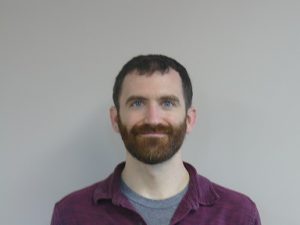Kevin Sunderland
Biomedical Engineering
 The sciences have been an interest of mine ever since my high-school years, but it was studying how the human body functions (and its numerous dysfunctions) that I found the most fascinating. This interest might be contributed to my (rather unfortunate) exposure to a variety of health problems that have impacted a number of my family and friends over the years. While people close to me have suffered from a variety of health concerns, but it was having to watch a family member struggle with neurological damage that I found the hardest to deal with. It wasn’t just how neurological damage can forever change a person, but it was also seeing how much the person’s family and friends also suffer when these conditions strike a loved one.
The sciences have been an interest of mine ever since my high-school years, but it was studying how the human body functions (and its numerous dysfunctions) that I found the most fascinating. This interest might be contributed to my (rather unfortunate) exposure to a variety of health problems that have impacted a number of my family and friends over the years. While people close to me have suffered from a variety of health concerns, but it was having to watch a family member struggle with neurological damage that I found the hardest to deal with. It wasn’t just how neurological damage can forever change a person, but it was also seeing how much the person’s family and friends also suffer when these conditions strike a loved one.
I pursued a degree in biology in college, and knew that after my undergraduate education I wanted to focus on health research. I was fortunate enough after college to begin working alongside a multidisciplinary research group that brought together talent from clinicians, nurse scientists, and engineers to study a variety of complex health issues. It was during this time that I was able to see just how much advances in technology lead the way in researching medical conditions and impacting the next generation of health. This drove me to pursue my graduate education and research in a place where I could combine my academic interests in health with current advances in technology. I have been lucky enough to find such an ideal place with the community here at Michigan Tech.
While neurological damage can come from a variety of places, a particular source can come from intracranial aneurysms: ballooned sections of blood vessels in the brain. When an aneurysm ruptures, it can damage a person’s brain, leading to a lifelong struggle dealing with the loss to both their physical and cognitive function (if a person survives at all). Now current surgical treatments used to prevent aneurysm rupture have proven be highly beneficial for many people, but these treatments carry their own potential risk to cause brain damage. So we have a paradox: aneurysm rupture is devastating but not all aneurysms rupture, and treatment options can save lives but also may lead to the same outcomes as an aneurysm rupture itself. So, it would be best to limit surgery only to patients who are at risk of aneurysm rupture. If we were to better predict which aneurysms may rupture, we may be able to spare some patients from potentially unneeded surgery, only intervening when an aneurysm is at serious rupture risk. This could help reduce the number of people who may have to struggle with neurological damage, whether it be from the aneurysm itself, or surgical intervention.
Michigan Tech has been perfect for allowing me to tackle this profoundly deviating source of neurological damage. My current research combines computer-modeling, fluid dynamics, medical imaging, and vascular biology to computationally study how complex blood flow patterns within aneurysms could be used to better predict which aneurysms are at a risk of rupturing. It is my hope at the very least, that my work could help protect individuals (and those that care for them) from having to suffer the tragedy and heartbreak stemming from neurological damage: either from aneurysm rupture, or from (unneeded) surgery.
Thanks to the funding from the Portage Health Foundation, I can perform this first crucial step in my research to better understanding the complex nature of aneurysms and their potential to rupture. The work I do here could set the groundwork for potential future studies for not only myself, but other health science researcher as well. Future studies could be based off of my current work could help to determine just what specific changes to aneurysms are caused by blood flow patterns and could help lead to improved treatment option. With the help of the PHF, I hope to make strides in protecting others and their loved ones from having to struggle with the tragic outcomes of the neurological damage that can come from having an intracranial aneurysm.